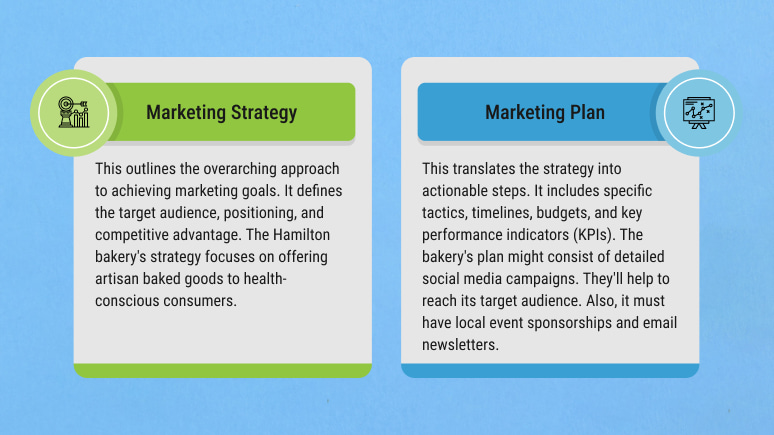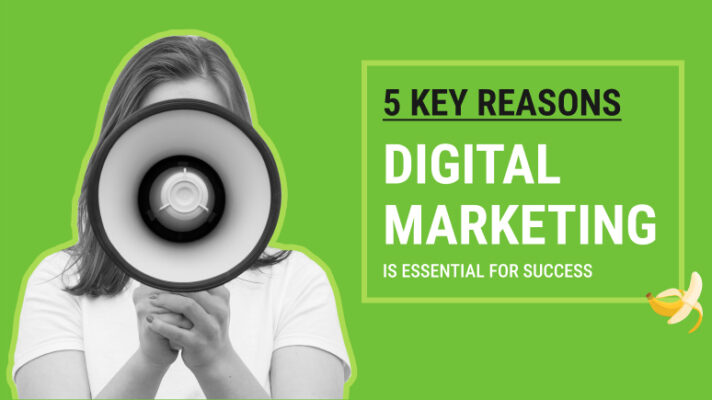The term “strategy” is often tossed around in business discussions. It’s a buzzword that signifies a plan for achieving success. But, at its core, what is a digital marketing strategy?
A digital marketing strategy is a planned framework that outlines how a business will use digital channels to achieve its marketing objectives. A well-crafted strategy ensures a brand’s visibility and fosters meaningful engagement with its audience. In Hamilton’s competitive digital market, a tailored approach is particularly significant. Understanding local nuances, preferences, and behaviours is crucial for creating strategies that resonate with the audience.
For example, Mulberry Street Coffeehouse might leverage social media to highlight its connection to the city’s art scene by featuring local artists and their works and promoting its popular Lavender Latte. This strategy attracts the vibrant community of art enthusiasts and coffee lovers in the area. Voila!
See how it’s essential to understand what the marketing strategy process is? Knowing the requirements of crafting a strategy allows businesses to position themselves for success. It helps them reach and captivate potential customers in a highly competitive market. Strategy creation is a complex and rich process, but don’t worry—we’re here to help you navigate it effectively.
So, grab a cup of coffee, roll up your sleeves, and let’s dive into the essentials of digital marketing strategy. It’s time to turn your marketing efforts into something buzz-worthy.
Decoding Digital Marketing Strategy for Success

What is a digital marketing strategy?
Why is it crucial for business success?
Our comprehensive plan outlines how a business will leverage digital channels and platforms. It helps to achieve your marketing objectives, is a roadmap for guiding digital marketing efforts, ensures alignment with overall business goals, and maximizes return on investment.
What is the marketing strategy process? Its critical components include:
- Audience Research and Segmentation: Understanding the customer’s demographics and preferences. It enables tailored messaging and targeted campaigns.
- Clear Objectives and Key Performance Indicators (KPIs): Setting specific, measurable goals ensures focus. It provides benchmarks for evaluating success.
- Channel Selection and Optimization: This includes social media, search engines, email, and websites. Optimizing content for each platform to maximize reach and engagement is vital.
- Content Strategy: Developing high-quality, relevant content is pivotal. It must be generally tailored to the customer’s interests and needs. It establishes credibility and drives their engagement.
- SEO: Optimizing website content improves visibility in search engine results. It drives organic traffic and enhances online presence.
- Paid Advertising: Utilizing Google Ads and social media ads. They help to target specific audiences and amplify reach.
- Web Design and User Experience: A perfect website will attract users. Mobile responsiveness is also essential for driving conversions.
The importance of web design in a digital marketing strategy is priceless. A user-friendly website with intuitive navigation and clear calls to action (CTA) enhances the user experience and encourages visitor retention. It is also critical in shaping brand perceptions.
For instance, The Cannon, a popular coffee shop in Hamilton, revamped its website to include an easy-to-navigate menu, an online ordering system, and clear CTAs for popular events like latte art workshops. The website also highlights The Cannon’s strong sense of community, emphasizing connections with staff, suppliers, and customers. This integration of web design considerations into their digital marketing strategy has helped The Cannon achieve real, tangible results, driving both online and in-store business success.
Now that’s enough coffee-talk.
Role of Web Design in Amplifying Digital Reach
The importance of web design in digital marketing strategy is really invaluable especially in Hamilton’s competitive market. A customer-driven marketing strategy requires a website that looks visually appealing. Check out the essential information below:
Girl on the Wing, a charming boutique in Hamilton, built its website to reflect its unique vintage-inspired aesthetic and community focus. They incorporated an engaging blog with fashion tips and local events, an interactive lookbook showcasing their seasonal collections, and a section highlighting their hand-picked vintage items and high-quality basics.
Additionally, their website features seamless integration with social media platforms and easy online shopping for their thoughtfully curated products. This approach enhances the user experience and effectively communicates the brand’s story and values, creating a welcoming online atmosphere that mirrors their in-store experience.
Now, let’s break down why good web design is so important:
| Aspect of Web Design | Explanation |
|---|---|
| Aesthetics | Schemes, typography, and imagery capture attention. They create a positive first impression. And in Hamilton’s competitive market, an aesthetically pleasing website can differentiate a brand. |
| Functionality | User-friendly navigation, fast loading times, and mobile responsiveness enhance usability. An intuitive website layout ensures visitors can easily find the information they seek. |
| Impact on User Experience | Effective web design contributes to a seamless and enjoyable browsing experience. It fosters trust and credibility with users. |
| Conversion Rates | Well-designed websites with clear CTA and optimized conversion paths facilitate conversions. Also, they lead generations. |
Prioritizing aesthetics and functionality in web design is paramount for businesses to amplify their digital reach. It helps them stand out in the crowded online area and ultimately leads to tremendous success in reaching Hamilton’s target audience.
Driving Growth with Customer-Centric Strategies
A customer-driven marketing strategy places the customer at the center of all marketing efforts, ensuring that interactions and content are tailored to meet their needs. This approach builds long-term relationships and drives growth by fostering trust, loyalty, and advocacy among customers.
Take, for instance, Detour Coffee Roasters, a popular coffee roastery in Hamilton.
Detour Coffee Roasters has built its marketing strategy around understanding and catering to its customer’s preferences. By gathering feedback through surveys and social media interactions, they have tailored their product offerings and content to match their customers’ tastes.
They regularly share behind-the-scenes content about their roasting process, highlight their sustainable sourcing practices, and engage with their community through coffee-tasting events and workshops.
This customer-centric approach has not only fostered a loyal customer base but also driven growth by turning satisfied customers into brand advocates who spread the word about their favourite local roastery.
Here’s a roadmap for a solid customer-driven marketing strategy:

| Strategy | Explanation |
|---|---|
| Definition | Customer-driven marketing strategy prioritizes meeting customers’ needs, preferences, and expectations. It involves gathering data, analyzing feedback, and tailoring marketing efforts. This strategy creates personalized experiences that resonate with the target audience. |
| Importance | Building long-term relationships with customers is essential for sustainable growth. A customer-driven approach fosters trust, loyalty, and advocacy. It demonstrates a deep understanding of customers’ needs and consistently delivers relevant content. It is a valuable experience over time. |
| Tailoring Content and Interactions | Personalizing content based on customer preferences and behaviours enhances relevance. It resonates with individuals on a deeper level. For example: – Amazon recommends products based on past purchases. – Netflix suggests shows based on viewing history. – Spotify curated playlists tailored to users’ music preferences. These personalized recommendations increase engagement, encourage repeat interactions, and foster more robust connections and loyalty. |
Businesses can more effectively engage customers through personalized experiences and relevant content. This marketing strategy leads to increased satisfaction, retention, and business success.
Strategic Planning: Marketing Strategy vs. Marketing Plan

Marketing strategy and marketing plan are closely related. They serve different purposes in achieving business objectives:
- Strategy: This outlines the overarching approach to achieving marketing goals. It defines the target audience, positioning, and competitive advantage. The Hamilton bakery’s strategy focuses on offering artisan baked goods to health-conscious consumers.
- Plan: This translates the strategy into actionable steps. It includes specific tactics, timelines, budgets, and key performance indicators (KPIs). The bakery’s plan might consist of detailed social media campaigns. They’ll help to reach its target audience. Also, it must have local event sponsorships and email newsletters.
Businesses can effectively execute their efforts and achieve their objectives. They may do it by clearly defining the marketing strategy vs. marketing plan.
Automating Success: Integrating Marketing Automation
This strategy revolutionizes business operations. It streamlines processes and enhances efficiency across various marketing tasks. Here’s how it works:
- Streamlining Processes: Marketing automation tools automate repetitive tasks. They are marketing, social media posting, and lead nurturing. This frees up valuable time for marketers. It helps to focus on strategy and creativity rather than manual execution.
- Enhancing Efficiency: Automating routine tasks is crucial so that marketing teams can accomplish more in less time. This efficiency leads to quicker campaign execution and improved overall productivity.
- Improving Customer Interactions: Marketing automation strategy allows for personalized communication at scale. Businesses can deliver targeted messages that resonate with individual customers. They must segment audiences based on demographics, behaviours, and preferences.
- Personalization: Marketing platforms enable dynamic content creation and delivery. It is always tailored to each recipient’s interests and actions. This level of personalization enhances the customer experience, driving engagement and loyalty.
Integrating a marketing automation strategy in Hamilton’s competitive market is vital. It can provide businesses with a significant competitive advantage. Automating repetitive tasks, improving customer interactions, and personalizing communications are also pivotal. So, companies can streamline operations and drive engagement. They may ultimately achieve tremendous success.
Inclusivity in Marketing: Reaching a Diverse Audience
Such a strategy prioritizes diversity and representation. It ensures that campaigns resonate with audiences from all backgrounds and identities. Here’s why it’s essential:
- Representation Matters: Inclusive marketing reflects society’s diversity. It makes all individuals feel seen, heard, and valued. Showcasing diverse perspectives and experiences is crucial. Businesses foster a sense of belonging and connection with their audience.
- Expanding Reach: A diverse audience has varied interests, needs, and purchasing behaviours. An inclusive marketing strategy allows businesses to reach and engage with a broader range of demographics. It maximizes their market potential and drives growth.
- Building Trust and Loyalty: More natural: “When consumers see themselves represented in marketing campaigns that are more likely to trust and relate to the brand. Inclusive marketing builds credibility and fosters long-term relationships with customers. It leads to increased loyalty and advocacy.
It is crucial to understand how to create inclusive campaigns in Hamilton:
- Diverse Representation: Ensure that your marketing materials feature diverse people. They must be from different ethnicities, ages, genders, abilities, and backgrounds.
- Cultural Sensitivity: Respect cultural nuances. Avoid stereotypes or cultural appropriation in your messaging and imagery.
- Accessibility: Make your marketing materials available to individuals with disabilities. Use alt text for images. Provide captions for videos and ensure website accessibility.
- Community Engagement: Involve the local network in your marketing efforts. Collaborate with local influencers, organizations, and events. They must represent diverse demographics.
Adopting an inclusive marketing strategy is crucial for businesses in Hamilton to help them attract a broader audience and contribute to creating a more inclusive society. Celebrating diversity and embracing authenticity is pivotal so that businesses can resonate with various demographics. It fosters a sense of belonging and connection within the community while driving growth in the local market.
From Tactics to Triumph: The Tactical Side of Strategies
Understanding the distinction between marketing strategy vs. tactics is essential for campaign success. Here is some vital information:
| Marketing Strategy | Tactics |
|---|---|
| It outlines the overarching approach to achieve objectives. They are target audience identification and competitive positioning. For example, a local bakery’s strategy might target health-conscious consumers. It offers artisan gluten-free products. | They are specific actions or methods used to execute the strategy. For the bakery, tactics could include offering free samples at farmers’ markets, partnering with local gyms for promotions, or hosting baking workshops. They engage the community. |
Practical, tactical approaches in local Hamilton markets include:
- Community Events Participation: Engaging with the local community through sponsorships in events. It may be festivals or fundraisers.
- Localized Advertising: Targeted advertising campaigns on Facebook or Google Ads. They focus on Hamilton-specific demographics or interests.
- Local SEO Optimization: Optimizing website content and listings for local search terms. They improve visibility in Hamilton’s search results.
Combining a well-defined marketing strategy vs. tactics is vital. Also, businesses must align overarching objectives with specific actions. So they can optimize resources and engage target audiences effectively. Also, they may stand out amidst the competition. It ultimately drives growth and success in the vibrant Hamilton market.
Learning from the Best: Marketing Strategy Case Studies
Examining strategy case studies from successful Hamilton businesses is vital. It provides valuable insights into practical approaches and lessons learned:
| Marketing Strategy Case studies | Overview |
|---|---|
| Urban Fitness Studio | This company utilizes targeted Facebook and Instagram ads to reach local fitness enthusiasts and promote gym memberships and classes. Urban Fitness Studio has a limited marketing budget and usually faces challenges in reaching customers. Targeted advertising allows the fitness studio to maximize its marketing efforts. |
| King W. Books | King W. Books offers unique, locally sourced products. It leverages social media to showcase its brand story and host virtual art workshops. Challenges include establishing brand recognition in a niche market. However, by emphasizing authenticity and building strong customer relationships, King W. Books has cultivated a loyal customer base. |
| Mustard Seed Co-op | The Mustard Seed Co-op sources locally grown produce, meats, and dairy. Facing competition from larger grocery chains, it attracts customers by emphasizing community-supported agriculture. This approach resonated with the community, helping the Mustard Seed Co-op differentiate itself. It’s truly a shame that they have closed. |
Examining these case studies from successful Hamilton businesses reveals key takeaways for implementing effective marketing strategies. These businesses have demonstrated the importance of:
- Customer Focus: Understanding and meeting your customers’ needs and preferences is paramount. Urban Fitness Studio, for example, uses targeted ads to connect with fitness enthusiasts, ensuring its marketing efforts resonate with its audience.
- Community Engagement: Building strong relationships within the community fosters loyalty and trust. King W. Books leverages its social media presence to engage with local artists and customers, creating a loyal customer base through authenticity and connection.
- Genuine Approach: Authenticity in your brand’s story and operations creates a lasting impact. Mustard Seed Co-op, despite its closure, showcased the power of emphasizing community-supported agriculture, which resonated deeply with its customers.
By focusing on these critical aspects—customer-centric strategies, community engagement, and genuine marketing efforts—local businesses in Hamilton can navigate challenges and stand out in the market. The successes of these highlighted businesses illustrate the potential of well-crafted digital marketing strategies to drive growth and create meaningful connections with customers.
As you develop and refine your digital marketing strategy, remember to integrate these principles. They are the foundation for capturing and retaining your target audience, ultimately leading to long-term success in Hamilton’s vibrant market.





